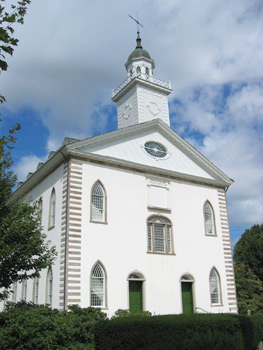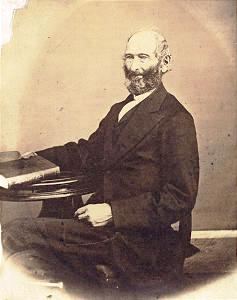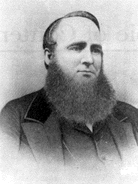
Kirtland is a city in Lake County, Ohio, United States. The population was 6,937 at the 2020 census. Kirtland is known for being the early headquarters of the Latter Day Saint movement from 1831 to 1837 and the site of the movement's first temple, the Kirtland Temple, completed in 1836. The Kirtland Temple and nearby Historic Kirtland Village are maintained as historic sites highlighting that era. The city is also the location for multiple parks in the Lake Metroparks system, as well as the Holden Arboretum.

Sidney Rigdon was a leader during the early history of the Latter Day Saint movement.
In the Latter Day Saint movement, the President of the Church is generally considered to be the highest office of the church. It was the office held by Joseph Smith, founder of the movement, and the office assumed by many of Smith's claimed successors, such as Brigham Young, Joseph Smith III, Sidney Rigdon, and James Strang. Several other titles have been associated with this office, including First Elder of the church, Presiding High Priest, President of the High Priesthood, Trustee-in-Trust for the church, Prophet, Seer, Revelator, and Translator. Joseph Smith was known by all of these titles in his lifetime.

The Latter Day Saint movement is the collection of independent church groups that trace their origins to a Christian Restorationist movement founded by Joseph Smith in the late 1820s.

The Latter Day Saint movement is a religious movement within Christianity that arose during the Second Great Awakening in the early 19th century and that led to the set of doctrines, practices, and cultures called Mormonism, and to the existence of numerous Latter Day Saint churches. Its history is characterized by intense controversy and persecution in reaction to some of the movement's doctrines and practices and their relationship to mainstream Christianity. The purpose of this article is to give an overview of the different groups, beliefs, and denominations that began with the influence of Joseph Smith.

Luke Johnson was a leader in the Latter Day Saint movement and an original member of the Quorum of the Twelve Apostles from 1835 to 1838. He served in the Quorum with his younger brother, Lyman E. Johnson, and Orson Hyde, his brother-in-law.

William Earl McLellin was an early leader in the Latter Day Saint movement. One of the original members of the Quorum of the Twelve Apostles, McLellin later broke with church founder Joseph Smith.

John Whitmer was an early leader in the Latter Day Saint movement. He was one of the Eight Witnesses of the Book of Mormon's golden plates. Whitmer was also the first official Church Historian and a member of the presidency of the church in Missouri from 1834 to 1838.
Hiram Page was an early member of the Latter Day Saint movement and one of the Eight Witnesses to the Book of Mormon's golden plates.
A Rigdonite is a member of the Latter Day Saint movement who accepts Sidney Rigdon as the successor in the church presidency to the movement's founder, Joseph Smith Jr. The early history of the Rigdonite movement is shared with the history of the Latter Day Saint movement, but as of the 1844 succession crisis becomes distinct. Sidney Rigdon and other church leaders, including Brigham Young and James J. Strang, presented themselves as leaders of the movement and established rival church organizations. Rigdon's group was initially headquartered in Pittsburgh, Pennsylvania. It was known at one point as the Church of Jesus Christ of the Children of Zion, and its adherents are referred to as Rigdonites, or sometimes "Pennsylvania Latter Day Saints" or "Pennsylvania Mormons." The only surviving organization that traces its succession back to Rigdon's organizations is The Church of Jesus Christ, founded by a group of Rigdon's followers led by William Bickerton.

Amasa Mason Lyman was an early leader in the Latter Day Saint movement and was an apostle. He was also a counselor in the First Presidency to Joseph Smith.

Lyman Eugene Johnson was an early leader in the Latter Day Saint movement and an original member of the Quorum of the Twelve Apostles. He broke with Joseph Smith and Sidney Rigdon during the 1837–38 period when schism divided the early church. Johnson later became a successful pioneer lawyer in Iowa and was one of the town fathers of Keokuk, Iowa.

Mantua Township is one of the eighteen townships of Portage County, Ohio, United States. The 2020 census found 4,576 people in the township.

Isaac Morley was an early member of the Latter Day Saint movement and a contemporary of both Joseph Smith and Brigham Young. He was one of the first converts to Smith's Church of Christ. Morley was present at many of the early events of the Latter Day Saint movement, and served as a church leader in Ohio, Missouri, and Utah Territory.

Since its organization in New York in 1830, The Church of Jesus Christ of Latter-day Saints has had a presence in Canada. The church's first missionaries to preach outside of the United States preached in Upper Canada; the first stake to be established outside of the U.S. was the Alberta Stake; and the Cardston Alberta Temple was the first church temple built outside of the boundaries of the United States.
Ezra Booth was an early member in the Latter Day Saint movement who became an outspoken critic of Joseph Smith and the Church of Christ. He was "the first apostate to write publicly against the new Church". Before joining the early Church of Christ in 1831, Booth worked as a Methodist Episcopal minister and a farmer in Ohio. After his baptism, he moved with his family to Kirtland and served as a missionary, preaching in Missouri and Ohio. Booth left the church later in 1831, five months after his baptism. He proceeded to write a series of nine letters denouncing Mormonism that were published by the Ohio Star.

The John Johnson farm is a historic home and listing on the National Register of Historic Places in Hiram Township, just west of the village of Hiram, Ohio, United States. The home, built in 1828, is a significant location in the history of the Latter Day Saint movement as the home of Joseph Smith and his family from September 1831 to March 1832. While Smith lived at the home, it served as the headquarters of the Church of Christ and was the site of several revelations to Smith and other Church leaders. The Johnson Farm is also significant as the site of the tarring and feathering of Joseph Smith and Sidney Rigdon in March 1832.
Ziba Peterson was an early American Latter Day Saint best known as one of the four initial missionaries sent by Joseph Smith in 1830 to preach to Native Americans in Indian Territory. This mission brought in several influential converts and introduced the church to Kirtland, Ohio and Jackson County, Missouri, which would become religiously significant to Mormonism.

The following outline is provided as an overview of and topical guide to the life and influence of Joseph Smith:
















